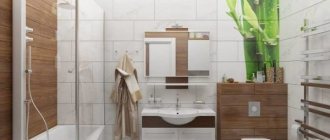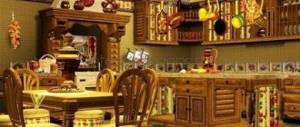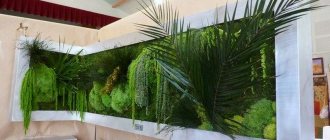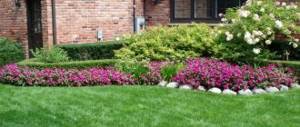You can make a suburban area beautiful by taking into account the practical use of the land. The planning of the vegetable garden and garden is carried out taking into account the characteristics of the soil and the location of the cardinal directions. On the territory free from beds and fruit trees, places for recreation are arranged and outbuildings are placed.
When starting to plan a vegetable garden or garden, it is important to understand what exactly you want to see on your site
Planning rules or how to plan a vegetable garden
Before drawing up a detailed plan, it is advisable to decide on the type of layout. Adherents of strict lines and forms prefer regular planning. Trees and shrubs are planted in even rows, beds and flower beds are made in the form of geometric shapes. The paths are also laid. The voids are filled with lawn.
It is necessary to start planning with a site diagram, on which the location of buildings, paths and areas allocated for the garden and vegetable garden should be noted
First of all, you need to decide on the place for the garden and the size of the allocated area.
There is a landscape layout, close to the natural style, of a garden plot and vegetable garden; how to draw up a garden plan is decided based on the features of the relief. Garden and garden crops are combined with ornamental plants and herbs. The planting plan for the summer cottage includes vegetable crops, fruit and stone fruit trees, and berry bushes. Many of them can be used as decorative elements.
The sunniest place is allocated for the beds, without shading on the south side
The length of the beds can be arbitrary, but the width is such that you can reach the middle of the bed with your hand
There are no standards for the ratio of the area of the garden and vegetable garden to the area of the plot; it all depends on the needs of the owners of the plot.
When arranging a vegetable garden, you should not mindlessly copy other people’s experience, but you should know some general principles
It is important to follow the basic rules:
- The vegetable garden is placed on a flat, warm place away from trees and tall buildings.
- Trees are planted on the north side so as not to cast a shadow on vegetable plantings.
- Berry bushes are used for zoning areas and hedges.
- Between the beds it is allowed to lay out flower beds and flower beds.
With the correct arrangement of beds and fruit trees, it will be possible to obtain a harvest and create a harmonious landscape design.
For cold climates, a greenhouse is not a luxury, but a necessity
Nowadays, it has become fashionable to arrange a decorative vegetable garden, in which vegetable crops also perform decorative functions.
Beetroot and carrots can be added to the flower garden. Decorative greenery will highlight the beauty of nasturtiums; calendula and marigolds will protect vegetable crops from insect pests.
When choosing plants for planting together, it is necessary to take into account their likes and dislikes.
Selecting a location
To ensure that your garden always looks decorative, it is important to take into account some recommendations:
- Plants must have access to sunlight, as most vegetable crops are heat-loving.
- The vegetable garden must be placed in a place where the plants are not exposed to direct sunlight, otherwise the leaves will begin to dry out and the beds will lose their attractiveness.
- An ornamental vegetable garden in a garden should not be planted in the shade of tree crowns. This is especially true if you plan to create permanent beds. Since the roots of the trees are large, they will take up moisture when watering the plants. Vegetables will not develop fully without receiving enough water.
Dividing the territory into zones
A rectangle for a garden and vegetable garden, of course, is easier to plan than a triangular or trapezoidal plot, a rhombus, or a plot on a slope. But even the most problematic area can be turned into a cozy landscape composition if you approach the design creatively.
Dividing the site into zones will help to correctly distribute the territory
Knowing the canons of zoning, you can independently plan a garden of 4 acres, 6, 8 or 12 for planting; the scheme provides for several main zones.
When zoning a territory, it is important to take into account the cardinal directions, prevailing winds and features of neighboring areas
The front door occupies 6–8%, it is immediately visible; the main decorative load falls on this territory. It is recommended to make a rock garden or rock garden with a minimum of green spaces, use vertical gardening, and border plantings along footpaths.
The front area is the face of the site, on which the first impression of the owners of the house depends
Fruit trees, berry gardens, and shrubs must not be placed near driveways or parking lots. Only decorative, unpretentious perennials are planted and lawns are made.
The gardening area is a place for planting useful crops, placing greenhouses, greenhouses. Usually occupies up to 75% of the site area; the sunniest areas are chosen. Fruit trees can be placed closer to the seating area to create pleasant shade. Berry trees are planted on borders to improve the landscape. It is better to provide tiered plantings - in the background - tall trees, then shrubs. In the foreground, when planning the beds, they are combined with flower beds and lawns.
Varieties of fruit trees and shrubs must be selected taking into account local climatic conditions
To successfully grow garden crops, you need fertile soil. If the soil on the site is poor, you will have to import black soil, plant green manure and apply mineral fertilizers
It is better to place household buildings in low-lying areas, hide them in the shade of trees, behind border plantings, and green hedges. A recreation area and playground occupy 10 to 15% of the site. Even in a small area you can plan a functional, cozy place with a barbecue, garden furniture, a gazebo, and a swing. Having decided on the proportions, we move on to the details. How to correctly place fruit trees and shrubs in the garden on the diagram can be seen in the selection of photos.
Outbuildings are usually located in the most inconvenient places for gardening crops
A recreation area with a gazebo or pergola is placed in the depths of the site away from the roadway
The playground should be clearly visible from anywhere on the site
Fencing for garden beds
When arranging beds, it is useful to think about options for framing them. Properly selected fencing contributes to:
- giving the area a neat appearance;
- significantly simplifying the weeding process;
- maintaining the original shape (if there are fences, the beds do not crumble);
- effective moisture retention.
Fences can be created from a variety of materials, so creative summer residents can let their imagination run wild. To perform such tasks they often use:
- tree;
- metal constructions;
- slate;
- plastic.
The main criterion when choosing the optimal material for fencing is its safety. It is not recommended to use materials that, when exposed to sunlight or natural precipitation, can release toxic substances. Otherwise, you can provoke health problems.
So, using photos of modern courtyards in the village, creative ideas from designers, you can create a unique design for a vegetable garden with beds near your private home.
Related publications
- Read
Making beautiful garden beds
- Read
Beautiful garden beds at the dacha with your own hands: photo
- Read
How to make a wooden path with your own hands at the dacha
- Read
Budget options for paths between beds
- Read
Crafts from disks for the garden
- Read
Mixed style of territory design
Free planning of a vegetable garden is a budget option for landscape design without strict zoning. Ideal for an area with uneven terrain, a variety of outbuildings in different places.
Mixed design style suits both small and large areas equally well
First, buildings are marked on the plan and shady areas are shaded. Sunny areas of the territory are used for cultural plantings, paths are laid in the rest, flower and stone compositions and lawns are made. They achieve rational use of all corners of the site, combining garden plantings with decorative ones. Useful crops are harmoniously woven into the design of the site and produce a good harvest.
With a mixed layout, plants are planted according to a pre-thought-out scheme, but not in a strict order, but in groups, combining fruit trees and shrubs with ornamental vegetation
When allocating a plot of land for fruit and stone fruit crops, the growth of the crown should be taken into account. You can use fruiting crops for background vegetation.
Forming beds
Garden beds should first and foremost be comfortable. It is necessary to take into account the watering regime of your plants - those that need the most water should be located in the most accessible place. But since the element of aesthetics is also important in the design of a vegetable garden, for a neat appearance, delimit each area. Let the beds have clear geometric contours - it will look very attractive.
beds
Sometimes you can't do without raised beds. We are talking about cases where the soil on the site is far from ideal. This way you will provide good conditions for the vegetables. It is not necessary to raise the entire garden; limit yourself to individual beds. You will spend time forming them, but then you will appreciate how convenient it is to water them without bending over. To spend your energy more efficiently caring for your garden, plant greens and crops that require the most care in high beds.
Preparing the beds
Raised beds
The correct width of the beds is important. There is no need to make them too wide, maximum 90 cm. As for the length, it can be any. The optimal distance between the beds is about half a meter. It is best to place the beds in the direction from south to north. The landscape in this area will be complemented by fencing for beds made of bricks, boards, and mesh.
What are the best trees to plant?
Trees create a special atmosphere of comfort and color. The location of fruit and stone fruit trees depends on the level of groundwater. Crops need good drainage, room for roots to grow, and enough light. They will not grow in low-lying and flooded areas.
Fruit crops are selected taking into account their further growth and pollination needs
When planting low-growing berry bushes, their need for sunlight is taken into account.
There is a standard set of fruit-bearing zoned crops; apple trees, pears, plums, and cherries (grow throughout Russia) are selected from this list. In the middle zone, apricots bear fruit, mulberries grow, and sea buckthorn grows in the Urals and Siberia. Coniferous trees and shrubs always look advantageous.
Landscape design of a vegetable garden at the dacha and its photo
Now some garden owners are not inspired by the idea of a vegetable garden, but there are also gardening fanatics, and most plot owners combine growing ornamental and edible plants. How nice it is to harvest your own crop of new potatoes while they are not on the market or are too expensive. If you compare the taste and appearance of cucumbers just picked from the garden with cucumbers bought at the market, the difference is also obvious.
On the other hand, it has long been known that mature fruit trees and fruit bushes - apple and pear trees, cherries and plums, serviceberry, gooseberries, red and white currants - are unusually decorative. More and more gardeners are planting them not only to be able to pick a berry from a currant or gooseberry bush they grew with their own hands and, perhaps, to make preparations for the winter, but also for beauty.
The landscape design of a vegetable garden in the photo may not look very practical, since most summer residents are accustomed to a different order in their garden beds.
Properly grown vegetables are attractive and elegant. Well-groomed beds are pleasing to the eye.
Look at the design of the garden at the dacha in the photo and appreciate the attractiveness of the planned beds:
Selection of ornamental plants
Berry bushes are chosen from the point of view of productivity and decorativeness. Gooseberries and currants are suitable for border and zone planting, hawthorn, red bird cherry, and chokeberry are suitable for hedges. Barberry and honeysuckle tolerate pruning well. Raspberries and blackberries are placed along the fence, along the boundaries of the site or in rows near outbuildings. Dogwood, shadberry, viburnum, and red-leaved apple trees are planted as ornamental plants.
For a small area, it is better to select unpretentious plants that can perform a dual role. For example, barberry - on the one hand, it is a beautiful ornamental plant, and on the other hand, it is a joy for cooks and connoisseurs of traditional medicine.
Dwarf apple and pear trees are another practical solution for a small area
When planning a vegetable garden, beds, plantings, the design takes into account the compatibility of plants, the biological characteristics of crops, and the requirements of agricultural technology: frequency of watering, requirements for lighting.
Planting a variety of plants on the site will allow you to enjoy an attractive view throughout the year.
You need to plan your landscaping for the entire season. Perennial flowers are added as annuals, taking into account the flowering period, so that there will be flowers in different parts of the area all season. Shrubs that change leaf color in the fall are placed in the front area. Unpretentious crops are placed in hard-to-reach places, while those requiring care are placed in a free access zone. Crops are combined compositionally, coniferous crops with deciduous ones.
To decorate rockeries, you can use herbs and different types of lettuce. Flowers are planted in vegetable beds to repel pests.
Don’t forget about ornamental plants, which play an important role in the overall atmosphere of the garden plot.
Options for planning a garden and vegetable garden on a site with diagrams, photos of the best design solutions are presented in the selection. Other people's works inspire you to realize your own ideas.
Plants
A DIY decorative garden will always be attractive if you choose the right plants that will feel comfortable next to each other. Very often, some cultures cannot tolerate the proximity of others. Such growth should be excluded.
In addition, we should not forget that the main task when creating decorative beds is beauty. In order for it to remain throughout all seasons of the year, you need to select plants for your garden so that they match the shape and colors. However, the characteristics of each culture should be taken into account. Plants of the following types are very popular:
- Cabbage crops – cabbage: white and red, kohlrabi, cauliflower, Brussels sprouts.
- Root vegetables - beets, carrots, radishes, celery, parsley, parsnips.
- Tuberous vegetables - potatoes.
- Bulb crops – onions of different types.
- Leafy plants – dill, spinach, lettuce.
- Fruits - peppers and tomatoes, eggplants and cucumbers, squash and pumpkin, zucchini and watermelons, melons and beans, beans, peas and corn.
- Perennial crops – asparagus, sorrel, rhubarb, horseradish.
When combining crops, you need to pay attention to the admissibility of their proximity. For example, sweet and bitter peppers, vegetables and poisonous herbs should not be planted nearby.
Photo: A selection of successful planning solutions
How to decorate a vegetable garden with your own hands
Independent design of a plot for a vegetable garden always consists of several main stages, starting from choosing a location, design style, developing a drawing and ending with the organization of beds, with the choice of suitable vegetation for them. Of course, each of these actions has its own characteristic features that should not be forgotten.
Selecting a location
The location for organizing a vegetable garden should always be chosen taking into account the requirements of the plants that will be grown on it in the future. Usually this is an area hidden from cold winds, with deep groundwater and sufficient sunlight. Lowland wetlands are not the best solution for arranging beds, but if there are elevation changes in the landscape of the area, then cultivated plants can be planted on slopes, mainly in the northern and northwestern parts of the territory.
Other criteria that should definitely be taken into account at the planning stage include the distance of the garden plot from the water source (the plants will need to be watered regularly) and the characteristics of the soil composition (clay or sandy soil will have to be prepared for planting crops by adding black soil and fertilizers).
Layout and drawing
When deciding how to design a plot for a vegetable garden, immediately decide what exactly you need it for. If only for growing herbs and greens, it can easily fit into the overall style of the local area, perhaps by dividing the rectangular area into shaped zones. In the case of growing standard vegetables and root crops, everything is somewhat more complicated, because they themselves will stand out against the background of the rest of the greenery in the garden. Once the first sketch of the site is ready, it's time to start developing more detailed drawings.
All of them provide for a clear calculation of the length, width, and sometimes even the depth of each individual bed, because for the convenience of further arrangement, it is worth thinking in advance where and what type of vegetables is best to plant. If necessary, you can make adjustments to the finished analysis of the site over time , especially if it turns out that the placement of the vegetable garden limits the possibility of movement to the recreation area or any other place in the common area. If you have to modify something or delete something from the general plan, it’s okay, the main thing is that this happens before the start of the planting campaign.
Important! Never plant plants in one place that already grew here last year and have managed to deplete the supply of nutrients from the soil. Compliance with the rules of crop rotation directly affects the quality and abundance of the harvest, which is why it is so important to carefully study the entire list of desirable and undesirable predecessors for each type of selected plants.
Selecting a design style
In modern landscape design there are many interesting design styles, many of which are suitable for vegetable garden design. The most popular today include:
- Eastern . The main features are the presence of pebbles, crushed stone and even boulders as decoration. When choosing, the color palette of the selected material, shape and size are taken into account, which is also important when decorating a vegetable garden (you can lay stones along the border of the vegetable garden or sprinkle them on individual bushes of greenery).
- Rustic (alternative names "country" or "rural") . Its main advantages are maximum simplicity and comfort, so traditional village vegetable crops are planted in the beds, and the perimeter of the garden can be supplemented with a low fence made of vines and old clay pots hung on long sticks.
- Modern . This style combines several others, in particular modernism, cubism and minimalism. When arranging terraces and paths, concrete slabs are often used, and when choosing the shape of the beds, special attention should be paid to square or round varieties. Plants in the garden are also planted in a certain sequence, always observing group distribution by species. The garden bed should not seem like chaos. The main task of modern style is strict adherence to geometric shapes and simplicity.
- Alpine . Here the emphasis is on the natural decorativeness of the planted crops and the overall attractive design of the garden. Most often, wild plants are placed in flower beds and rock gardens, but the option of using this style in relation to cultivated greenery cannot be ruled out. Vegetation can be supplemented with pebbles and stones of various sizes, characteristic of mountain slopes. The Alpine style is especially relevant for areas with noticeable differences in relief heights.
- Landscape . Characterized by maximum calm and naturalness. In addition to the classic garden, you can plant coniferous shrubs in such an area, creating an excellent hedge from them. The landscape style is perfect for uneven and asymmetrical areas, but the planted crops should be repeated periodically.
In landscape design, there are other popular styles for decorating a house plot , so if you decide to decorate it in accordance with the Mediterranean, French or even exotic style, then when arranging a vegetable garden you should adhere to their basic requirements for organizing space.
Organization of beds
Detailed planning of the division of the area allocated for the garden is one of the first and most important tasks, because you must have good access to all areas . Often, to achieve goals, small paths or hedges are used that follow the shape and direction of the beds. This process is completely individual, because while for one person identical areas with a clear structure of planted plants will be convenient, for another a chaotic arrangement of crops will be closer, the main thing is that this does not run counter to the general requirements of the style chosen for the dacha.
Did you know? One of the oldest styles in the design of space is the Chinese teaching of Feng Shui, associated with the harmony and circulation of qi energy in nature. Its first principles appeared more than 6,000 years ago, as evidenced by the results of archaeological excavations.
Clear geometric contours allow you to achieve visual accents in landscape design , while maintaining a sense of order and cleanliness. However, if there is a desire, no one will stop the summer resident from planting the selected crops in vertically standing poles, old cart wheels, or placing the same tomatoes in separate boxes displayed on the site in several dense lines. In high areas, it is worth setting aside space for greenery and difficult-to-grow crops. Intricate patterns and ornaments formed from slightly raised beds in the shape of trapezoids, waves or triangles only help to achieve originality in the process of gardening, although planting moisture-loving crops in this case would be inappropriate (water in such places dries out much faster).
The main recommendations when organizing beds on your site include advice regarding their parameters . For example, they should not be very wide so that each row of plantings can be easily accessed. At the same time, the length of the strips with plants can be absolutely any, the main thing is the possibility of easy maintenance of the entire path. When choosing a garden design, you should try several options, determining the most suitable one for yourself.
Selecting plants for planting
Standard crops for planting on the site are tomatoes, cucumbers, peppers, carrots, beets and a variety of salad greens. Each species has its own requirements for growing conditions and soil composition on the site, which is why it is so important to choose the most suitable growth site for them.
When planning to grow dill or parsley, try to sow only selected varieties in the front beds, placing the seeds close to each other (extra plants can always be pulled out to the table). In European countries, the combination of dill umbrellas with roses is often practiced, and curly parsley is often used to frame beds. The external features of a particular type of vegetation will tell you where it is best to plant it for maximum attractiveness of the site.
We advise you to read what it is and when you need to plant green manure for your garden.
Dwarf peppers, colorful cabbage and small pumpkins are other great garden additions . They can hardly be called full-fledged vegetables, but at the same time, such plants stand out well from the rest, making the garden unusual and interesting. If you do not want to combine these varieties with ordinary ones, you can create a separate, purely decorative bed, supplementing it with carrots or beets. The tops of these vegetables do not lose their appearance right up to the frost, and when planted densely, the growing root crops can be pulled out and used for food even before the harvest is complete at the end of autumn.
It is better to sow tomatoes, cucumbers and bell peppers in a separate, “real” vegetable garden, located away from human eyes, complemented by paved paths and beds fenced with a low fence. There will be no ceremonial beauty in such a place, but you will receive an environmentally friendly harvest, grown with your own hands . If desired, you can even grow strawberries in the recreation area, which, if wildly neglected, will have a beautiful appearance. To obtain a rich harvest of berries, you will have to carefully care for the plants every season, removing weeds, loosening and fertilizing the soil.
How to combine plants correctly
Sometimes the decorative and practical purposes of growing certain crops on a plot can be achieved simultaneously, you just have to figure out which plants can be planted together. For example, beds with greenery go well with roses and other flowers , so when planting vegetables in rows or small islands, in addition to them, you can place 2-3 flowering species around the perimeter of the plant, which will only add brightness to the composition.
We recommend reading, a diagram of planting flowers in a flower bed, we study the features.
Any herbaceous plants can be used to separate vegetable beds, the main thing is that they do not choke out the crops and have decorative foliage or flowers. When planted together, bushes with cherry tomatoes, marigolds, cabbage and small decorative deciduous shrubs look good. Pumpkins, carrots, green onions and beets can be combined into one flowerbed by sowing low-growing parsley around its perimeter.
Any flowering shrubs are suitable as a background. Alternatively, tasty and healthy sets of vegetables can be planted in closed beds-boxes located on supports along the house or a separate part of the garden, but in any case, the decorativeness of the plants will directly depend on the quality of their care.
Regular garden design
Choosing a garden in a regular style involves observing the rules of symmetry when organizing beds and flower beds. Their shapes can be different - square, rectangular, even round, the main thing is a clear pattern in their placement with the same passage width.
The beds will look especially neat if their fencing is made of the same material - wood, concrete, slate.
Classic rectangular garden beds in a regular style
Beautiful vegetable gardens are obtained in the shape of the sun, with rays diverging from the center - ridges.
Regular vegetable garden in the shape of the sun
Decorative vegetable garden - photos and ideas for planting arrangement
A decorative garden is a garden where there is no clear geometric rule for planting placement when planning it. The ridges can be of any shape, even curved, separated by passages or vice versa, smoothly flowing into each other.
The decorative garden is extremely effective; it is characterized by the fact that plants are planted not only on the ridge allocated for them, but also interspersed between other species. This is done to achieve a beautiful composition, or a combination of both. Arborvitae, junipers, and ornamental cabbage are often used for such “accents.”
Decorative vegetable garden, photo design in the shape of a wave
The beautiful vegetable garden, the photo of which you see, is made in a decorative style, with fences made of metal strips and has a smooth wave shape.
How to hide a vegetable garden on a plot
If the area for vegetables is quite large and clearly visible when examining the territory, you will have to figure out how to make it less visible so as not to disturb the overall design of the interior space of the dacha.
You can achieve the desired result and not show the beds in one of the following ways:
- Try to make this area invisible when looking at it from the porch, resting place or from the central gate, for which trellises with liana-like crops (for example, grapes, honeysuckle, hops or lemongrass) are usually used, or currants, gooseberries and chokeberries are planted around the perimeter.
- Incorporate a vegetable garden into the overall garden design by creating a plant composition of plants of different heights. If you combine ordinary vegetable crops with ornamental grasses and bushes planted between them, then tomatoes and cucumbers will not stand out so much from the overall picture.
Important! When planting ornamental vegetation next to cultivated plants, try to choose only varieties that are not prone to quickly spreading throughout the site. Seeds carried by the wind successfully germinate in various parts of the garden area and not always where required.
An alternative option for hiding a garden is to use decorative details on buildings for this purpose, in particular arches, fences, gates and other objects in the yard space. Unusual hanging pots with different flower crops or non-standard figurines installed on window sills or next to outbuildings will definitely distract attention from the garden. For the same purposes, bright hydrangea bushes are planted nearby or clearly visible flower beds, alpine slides are organized, or decorative ponds are arranged.











